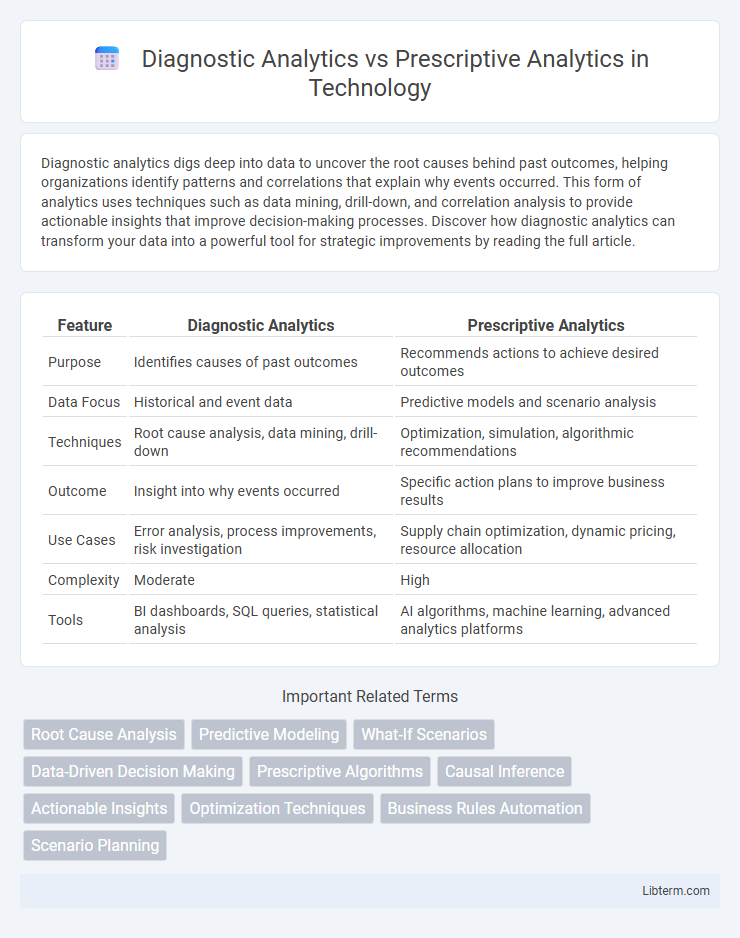Diagnostic analytics digs deep into data to uncover the root causes behind past outcomes, helping organizations identify patterns and correlations that explain why events occurred. This form of analytics uses techniques such as data mining, drill-down, and correlation analysis to provide actionable insights that improve decision-making processes. Discover how diagnostic analytics can transform your data into a powerful tool for strategic improvements by reading the full article.
Table of Comparison
| Feature | Diagnostic Analytics | Prescriptive Analytics |
|---|---|---|
| Purpose | Identifies causes of past outcomes | Recommends actions to achieve desired outcomes |
| Data Focus | Historical and event data | Predictive models and scenario analysis |
| Techniques | Root cause analysis, data mining, drill-down | Optimization, simulation, algorithmic recommendations |
| Outcome | Insight into why events occurred | Specific action plans to improve business results |
| Use Cases | Error analysis, process improvements, risk investigation | Supply chain optimization, dynamic pricing, resource allocation |
| Complexity | Moderate | High |
| Tools | BI dashboards, SQL queries, statistical analysis | AI algorithms, machine learning, advanced analytics platforms |
Introduction to Diagnostic and Prescriptive Analytics
Diagnostic analytics focuses on examining historical data to identify the root causes of past outcomes, utilizing techniques such as data mining, drill-down, and correlation analysis to uncover patterns and anomalies. Prescriptive analytics goes further by recommending specific actions based on predictive models, optimization algorithms, and simulation methods to guide decision-making and improve future results. Both analytics types are essential in transforming raw data into actionable insights, with diagnostic analytics explaining why events happened and prescriptive analytics advising on what steps to take next.
Defining Diagnostic Analytics
Diagnostic analytics identifies the root causes behind past business performance by analyzing historical data patterns and correlations. It uses techniques such as data mining, drill-down, and data discovery to understand why certain events occurred. This approach helps organizations pinpoint specific factors impacting outcomes, enabling targeted improvements.
Defining Prescriptive Analytics
Prescriptive analytics uses advanced algorithms and machine learning to recommend specific actions based on predictive insights, optimizing decision-making processes in organizations. Unlike diagnostic analytics, which focuses on understanding past events by analyzing historical data, prescriptive analytics goes beyond by suggesting the best course of action to achieve desired outcomes. Key applications include supply chain optimization, risk management, and personalized marketing strategies, driving business efficiency and competitive advantage.
Key Differences Between Diagnostic and Prescriptive Analytics
Diagnostic analytics identifies the causes of past events by analyzing historical data and patterns to explain why something happened, focusing on data interpretation and root cause analysis. Prescriptive analytics goes beyond diagnosis by recommending specific actions and predicting the outcomes of different decisions using advanced algorithms, optimization techniques, and machine learning models. While diagnostic analytics answers "Why did it happen?", prescriptive analytics addresses "What should we do next?" to optimize future results.
When to Use Diagnostic Analytics
Diagnostic analytics is most effective when businesses need to identify the root causes of past performance issues or anomalies by analyzing historical data patterns and correlations. Use diagnostic analytics during problem-solving phases to uncover why specific trends occurred, such as decreases in sales or operational inefficiencies. This approach supports informed decision-making by revealing underlying factors driving outcomes, enabling targeted interventions and improvements.
When to Use Prescriptive Analytics
Prescriptive analytics is used when organizations need actionable recommendations to optimize decision-making and operational efficiency by predicting future outcomes and suggesting the best course of action. It is ideal in complex scenarios such as supply chain management, financial planning, and personalized marketing, where multiple variables influence outcomes and prescriptive models can simulate various strategies. Businesses should use prescriptive analytics after diagnostic analytics identifies the causes of issues, enabling a data-driven approach to solve problems and seize opportunities.
Data Requirements for Diagnostic vs Prescriptive Analytics
Diagnostic analytics requires detailed historical data sets, including event logs, transaction records, and customer interactions, to identify patterns and root causes of past outcomes. Prescriptive analytics relies on not only historical data but also real-time data streams, predictive models, and external variables to recommend actionable decisions and strategies. The volume, variety, and velocity of data are typically higher in prescriptive analytics due to its forward-looking and dynamic nature.
Real-World Applications and Industry Examples
Diagnostic analytics identifies patterns and root causes in historical data to explain why events occurred, commonly used in healthcare for patient outcome analysis and in manufacturing for defect detection; prescriptive analytics recommends actions based on predictive models, optimizing decisions such as supply chain management in retail or dynamic pricing in airlines. In finance, diagnostic analytics helps detect fraud by analyzing transaction anomalies, while prescriptive methods tailor investment portfolios to maximize returns under risk constraints. Energy companies leverage diagnostic insights to identify equipment failures, whereas prescriptive analytics advises on maintenance schedules to minimize downtime and costs.
Benefits and Challenges of Each Approach
Diagnostic analytics enhances understanding by identifying the root causes of past performance issues, enabling targeted decision-making through data-driven insights and patterns. Its benefits include improved problem-solving and process optimization, while challenges involve reliance on historical data quality and limited predictive capabilities. Prescriptive analytics extends beyond diagnosis by recommending actionable strategies for future outcomes, offering real-time decision support and scenario analysis; however, it faces challenges in model complexity, integration with operational systems, and the need for continuous data updating.
Choosing the Right Analytics Strategy for Your Business
Diagnostic analytics examines historical data to identify the root causes of business outcomes, enabling companies to understand why certain events occurred. Prescriptive analytics builds on this by recommending specific actions based on predictive models and optimization techniques to improve future results. Selecting the right analytics strategy depends on business goals, with diagnostic analytics suited for problem-solving and prescriptive analytics ideal for decision-making and strategy enhancement.
Diagnostic Analytics Infographic

 libterm.com
libterm.com